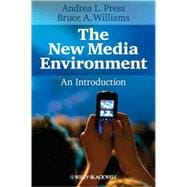
Note: Supplemental materials are not guaranteed with Rental or Used book purchases.
Purchase Benefits
Looking to rent a book? Rent The New Media Environment: An Introduction [ISBN: 9781405127677] for the semester, quarter, and short term or search our site for other textbooks by Andrea L. Press (University of Virginia, USA); Bruce A. Williams (University of Virginia, USA). Renting a textbook can save you up to 90% from the cost of buying.
| Acknowledgements | p. viii |
| Introduction: Modem Life Is a Media Experience | p. l |
| A Tale of Two Hurricanes | p. 2 |
| What Is a Media Environment? | p. 8 |
| The Importance of Changing Media Environments | p. 10 |
| The electronic media | p. 12 |
| Media in the Twenty-First Century: What Has Changed? | p. 16 |
| The age of the internet | p. 19 |
| Conclusion | p. 21 |
| Ownership and Control in the New Media Environment | p. 26 |
| Patterns of Media Ownership and Control | p. 26 |
| Ownership and Control of the Media: Assumptions and Realities | p. 32 |
| Alternative models of media ownership | p. 35 |
| Who owns the media? | p. 37 |
| Ownership and control in a global context | p. 46 |
| Does It Matter? The Consequences of Concentration and Conglomeration | p. 48 |
| The argument for market-driven media | p. 48 |
| The argument against market-driven media | p. 49 |
| What this means today | p. 55 |
| Conclusion | p. 56 |
| Media and Democracy | p. 63 |
| Introduction | p. 63 |
| Changing Media Environments and Changing Democratic Politics | p. 68 |
| Why nervous liberals are still with us: The enduring problem of propaganda | p. 71 |
| John Dewey and the reconstruction of media and democratic politics | p. 74 |
| Empirical research: How do media actually affect citizens? | p. 75 |
| Television and the "Age of Broadcast News" | p. 79 |
| Politics in the New Media Environment | p. 84 |
| Conclusion | p. 87 |
| Studying Popular Culture: Texts, Reception, and Cultural Studies | p. 91 |
| Introduction: Hollywood and Representations of Reality | p. 91 |
| Media Studies and the Study of Reception: A Brief History of Its Methods and Findings | p. 101 |
| Conclusion | p. 107 |
| Studying Inequalities: Class, Gender, Race, and Sexuality in Media Studies | p. 112 |
| A Critical Perspective on Inequality in Media Studies | p. 112 |
| The Frankfurt School | p. 116 |
| Cultural studies | p. 116 |
| Media studies research findings on class, gender, race, and sexuality | p. 119 |
| Gender in Media Studies Research: Are Gender Roles Culturally Reproduced? | p. 124 |
| Film and gender: Issues of reception and representation | p. 128 |
| Television and gender: Issues of reception and representation | p. 132 |
| Media and Race | p. 136 |
| Sexuality | p. 144 |
| Conclusion | p. 148 |
| Studying Media Texts and Their Reception in the New Media Environment | p. 156 |
| Transformative Images in the New Media Environment | p. 160 |
| Globalization and the new shape of media identities | p. 162 |
| Media Reception Research in the New Media Environment | p. 163 |
| Global reception in the new media environment | p. 167 |
| Gender, Race, Sexuality, and Social Class Inequality in New Media Reception: A New Study | p. 169 |
| New Studies: Gender and Social Class Identities in the New Media Environment | p. 173 |
| Politics, Media Impact and Use, and the New Media Environment | p. 178 |
| Old and New Media in the Individualized Media Environment: The New Media Environment Is Never Just New Media | p. 181 |
| Bias in old media and new | p. 182 |
| Civic engagement in the new media environment | p. 184 |
| Americans and Political Discussion: How the New Media Environment Is Changing the Civic Landscape | p. 184 |
| Conclusion | p. 187 |
| Conclusion | p. 194 |
| We Are Living in a Mediated Age | p. 194 |
| The Complexity of Our Relationship With the Media | p. 196 |
| Human Agency in Media Decisions and Directions | p. 198 |
| In Closing: The Case of the RFID | p. 202 |
| Index | p. 205 |
| Table of Contents provided by Ingram. All Rights Reserved. |
The New copy of this book will include any supplemental materials advertised. Please check the title of the book to determine if it should include any access cards, study guides, lab manuals, CDs, etc.
The Used, Rental and eBook copies of this book are not guaranteed to include any supplemental materials. Typically, only the book itself is included. This is true even if the title states it includes any access cards, study guides, lab manuals, CDs, etc.